 Internal Communications Measurement
Internal Communications Measurement
If you’re wondering how to measure communication effectiveness, an excellent place to start is with a reliable, free internal communications audit.

.webp)
Measure the ROI of using modern internal communications. Get the template for free without any risk or commitment.
Access NowKey Findings on How to Measure Communication Effectiveness
Understanding and measuring internal communication effectiveness is essential for improving engagement, productivity, and strategic alignment. This post outlines key metrics, best practices, and tools for evaluating communication impact. Tracking communication effectiveness helps organizations refine strategies, enhance engagement, and align messaging with business objectives.
Are you wondering how effective your internal communications are? Not sure which metrics and measures to use to gauge performance and progress? Have you considered running a communications audit to better understand employee communication preferences?
Internal communicators often struggle with measuring internal communication. However, Gallagher’s State of the Sector 2024 report shows that internal communicators are getting better at measuring their impact. They are also measuring more often. In general, they found that “strategic” communicators focus more on “outcome metrics” like behavior change rather than outputs, which are “reach” metrics. At the same time, according to respondents, both have increased:
According to Gallagher’s State of the Sector 2023 report, only 63% of those in senior business positions reportedly measured communication “reach” — which is now 77%.
Furthermore, it is clear that an increasing number of communicators are using impact measurement to prove return on investment (ROI), with 84% saying they want to measure more often or more comprehensively. The 2023 report indicated that more than half of respondents (52%) were measuring mainly to prove return on investment (ROI) to their “leaders.” The 2024 report shows this figure has risen by 18% to 70%. Additionally:
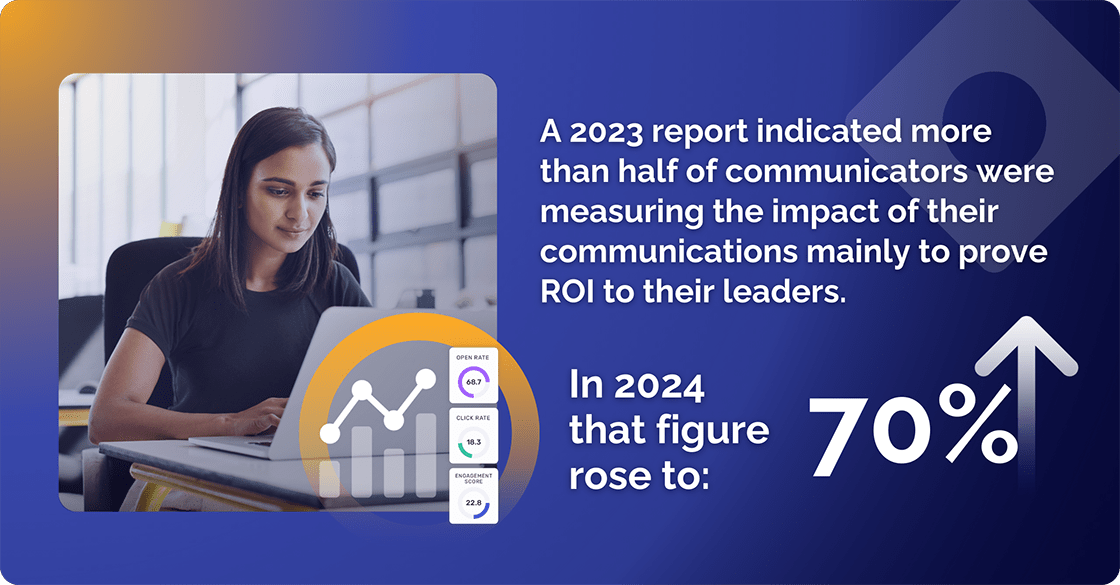
Another key takeaway from Gallagher’s 2024 State of the Sector report focuses on the value of communications audits. According to the report, there has been more than a 5% year-to-year increase on measuring employee satisfaction with internal communication that includes audits, surveys, and interviews.
“Years of conducting audits have shown us how invaluable they can be — one client even described their audit as ‘gold dust’ in resetting their internal comms approach. It allowed them to have a completely different conversation with leadership — one that furthered their internal comms transformation strategy.”
Gary Moss, Director, Internal Communication, Gallagher
Let’s look more closely at the need for internal communicators to measure the impact of their comms.
Efficient internal communication forms the essential basis of any successful business operation. A primary focus of this is making sure that a company’s strategic focus and goals are conveyed appropriately to its internal audience — the employees. Often overlooked, however, is the idea of measuring the effectiveness of these internal communications. Without proper measurement and monitoring, it is difficult, if not impossible, to determine if the intended message is reaching its target audience appropriately and eliciting the desired response.
In its The State of Organizations 2023 report, McKinsey & Company highlighted some of the challenges. For example, their survey found that 40% of respondents cite a lack of digital analytics capabilities and 32% lack software development capabilities. It also discovered that only 25% of respondents felt their leaders were engaged and inspiring!
A McKinsey article posted in June 2024, references this report, and examines the challenges of great leadership communication in more detail. Unlocking organizational communication: Five ways to ignite employee engagement suggests that leaders can enhance engagement by embedding communication at the core of their roles, choosing key messages wisely, and fostering two-way conversations with their teams. An October 2024 McKinsey article, Go, teams: When teams get healthier, the whole organization benefits, discusses how effective communication is a critical factor in team success. It notes that high levels of trust and communication are essential for creating effective teams, which in turn drive organizational performance.
Insights in both these articles underscore the significance of measuring and improving communication effectiveness to foster employee engagement and enhance overall organizational performance.
Understanding how to measure communication effectiveness can play a crucial role in boosting productivity and shaping a positive workplace culture. So, let’s examine exactly why we need to measure internal communication
Quantify the financial benefits of your internal communications
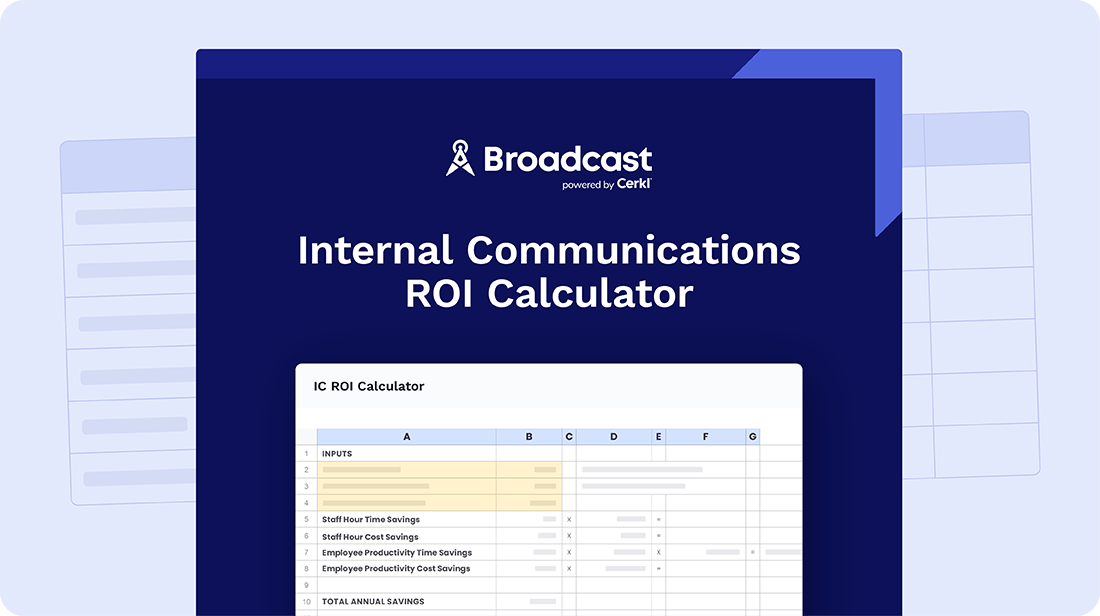
Initially, measuring internal communications will help to gain employee insights. This can prove to be a vital resource for honing the efficacy of ongoing communications. Using tools like discussion forums, regular surveys, and focus groups can help understand employees' perceptions and attitudes toward the messaging.
Another important factor is the need to define and monitor communication goals. Every internal communication plan should have key performance indicators (KPIs) with specific benchmarks they need to achieve. Examples of quantitative communication KPIs include email open rates for internal newsletters, while qualitative communication KPIs may be gauged through focus group sentiment analysis.
Defining these KPIs can provide your communications team with a clear vision to strive towards. They will, though, need to monitor them regularly to ensure they stay on course. By setting a specific date and ROI target, internal communicators have a measurable goal that can drive efficiency and commitment.
Understanding how to measure communication effectiveness can guide the process of crafting better internal communications campaigns. This will draw on the insights gained from previous campaigns and should align with the company vision and the audience preferences. It’s a proven approach that will help to future-proof your strategies and ensure continued improvement in your communication approach.
Improving impact measurement and the evaluation of internal communications metrics remains a top priority for organizations in 2023. According to Gallagher’s 2023 State of the Sector report, it is number four on the list of priorities for organizations for 2023. Priorities that take precedence over “improving impact measurement and evaluation” are:
Of course, measuring internal communications can also play a significant role in informing strategic communication decisions. Businesses often find that different communication channels have varying effectiveness depending on the message, target audience, and timing.
For example, you might find that urgent updates are better received via SMS, while detailed project updates perform better via email. Such insights allow organizations to refine their channel selection, time their delivery, and adapt their communication style as per the desired outcome. These data-driven decisions can lead to an increase in market share and a greater communication reach for the business as a whole.driven decisions can lead to an increase in market share and a greater communication reach for the business as a whole.
Measuring internal communications can also significantly impact employee engagement and productivity. A clear and open communication structure, where employees feel seen, heard, and respected, fosters engagement and satisfaction and improves productivity.
McKinsey research shows that organizations with strong use of people analytics see an 80% increase in recruiting efficiency. They also see a 25% rise in business productivity, and a 50% decrease in attrition rates, where employees leave the workforce voluntarily.
Knowing how to measure communication effectiveness is not just ideal, it is crucial for maintaining and enhancing overall business performance. By prioritizing the measurement of internal communications, companies can improve communication efficiency, boost employee morale, and ultimately, achieve their business goals and objectives.
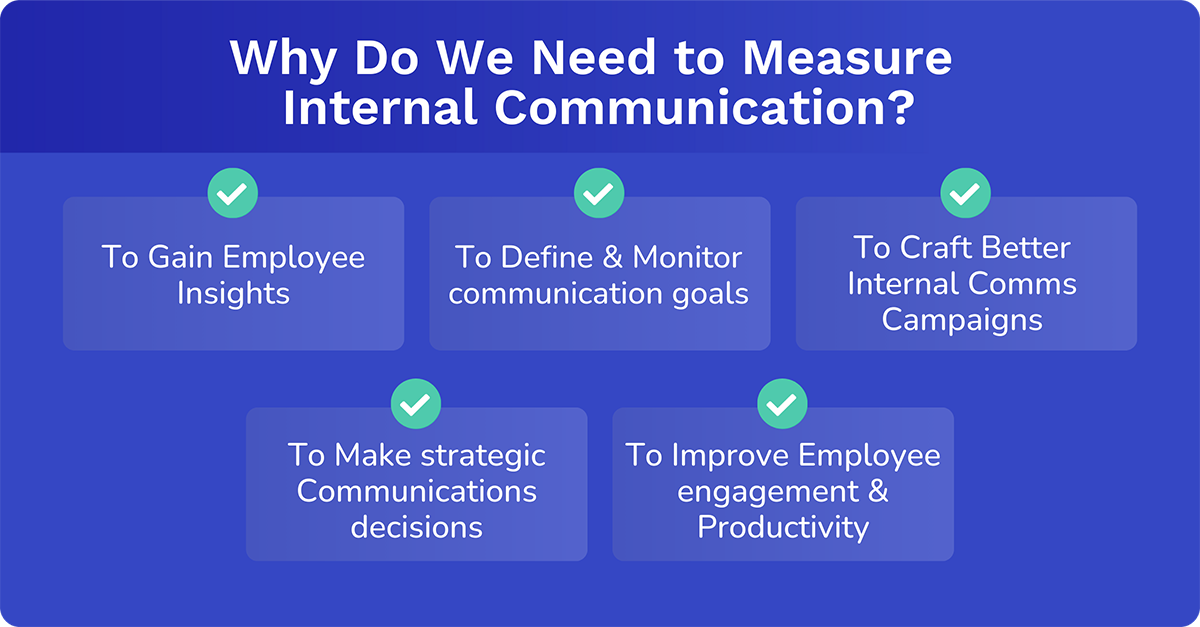
Despite a commitment by so many to continue to measure internal communication, there are major challenges that need to be factored into the equation. The biggest is a lack of time and/or resources (58%), followed by a lack of benchmarking data (44%). Technology — or rather the lack thereof — is another significant challenge. This manifests as a lack of available metrics (43%) as well as a lack of tools to analyze or collate data collected (39%). A fifth barrier is the lack of clear business targets and communication objectives.
But let’s turn back to the positives.
Determining the most suitable internal communications metrics and key performance indicators (KPIs) depends on your specific organizational goals, the nature of your communication efforts, and the channels you use. Here's a comprehensive list of potential communication metrics and KPIs to consider:
Selecting the most relevant metrics and KPIs will depend on your organization's specific communication goals. It's often beneficial to use a combination of these indicators for a more comprehensive, dependable assessment.
Quantify the financial benefits of your internal communications

Measuring communication effectiveness is crucial for ensuring that your messages resonate with your audience and contribute to organizational success. Here are five best practices to guide you in measuring communication effectiveness:
It’s imperative to clearly outline the objectives and goals of your communication efforts. Understand what you aim to achieve, whether it's improving the way employees engage, driving behavior change, or aligning communication with business objectives.
Setting clear objectives provides a foundation for selecting relevant metrics and KPIs. It helps you measure success against specific outcomes.
Combine quantitative metrics like survey responses, and open rates with qualitative insights such as sentiment analysis and feedback comments. This provides a more holistic view of communication effectiveness.
The reason you want to mix the two metrics is because quantitative metrics offer numerical data, while qualitative insights provide context and depth. The combination paints a more accurate picture of how your messages are received.
Before implementing changes or improvements, establish baseline measurements for relevant metrics. This serves as a point of comparison to assess the impact of your communication initiatives.
Ultimately, baseline measurements provide a benchmark for evaluating the success of your communication efforts. They help you understand the starting point and you can use them to track progress over time.
Implement regular feedback mechanisms like surveys, focus groups, or feedback channels. Use the data you collect to identify areas for improvement. Then adjust your communication strategies accordingly.
Regular feedback ensures that you stay responsive to the evolving needs and preferences of your audience. It allows you to make timely adjustments for more effective communication.
Ensure that the metrics and KPIs you choose align directly with organizational goals. Whether it's enhancing productivity, improving employee satisfaction, or achieving specific business outcomes, your measurement strategy should support these objectives.
Alignment with organizational goals ensures that communication efforts are contributing directly to the success of the business. It also facilitates clearer communication value propositions.
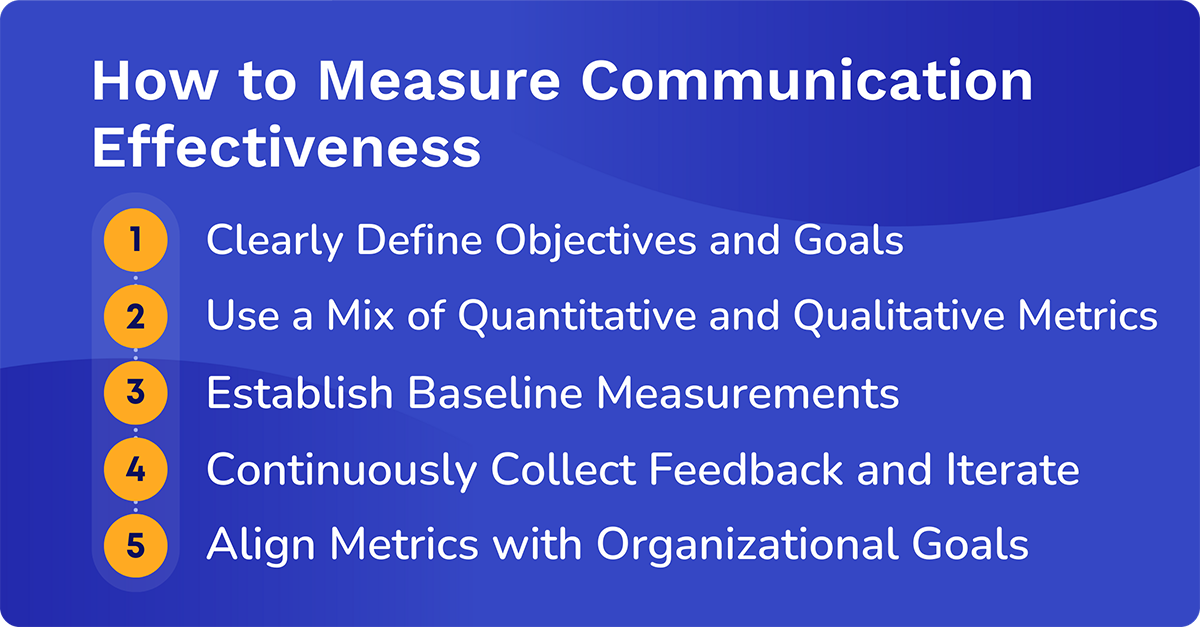
The leading integrated internal communications within a business setup significantly affect employee engagement, critical event management, and overall productivity. As such, measuring the effectiveness of internal communication becomes a strategic focus area for internal communicators to ensure a robust, seamless communication flow that fosters an engaging work environment.
There are several tools that internal communicators use to evaluate communication effectiveness. The most common are employee communication surveys, internal communications channel audits, and various types of employee communication software.
One of the most acclaimed tools used to measure internal communication is the employee communication survey. These surveys play a significant role in shedding light on employees' perceptions of communication within the company. They also reveal employee understanding of the company's objectives, leadership communication, privacy policy, and other pertinent informational materials circulated internally.
When designing employee communication surveys, it is crucial to focus on the key communication KPIs that tie directly to the organization's strategic focus and target appropriate responses from the target audience. For instance, asking open-ended questions can help determine if the communications team has effectively transmitted a message about a specific date for a critical company event. They will also reveal whether employees understood the communicated details.
A well-conducted survey goes beyond the basics. It can lead to greater communication between management and the workforce, thereby increasing market share through higher productivity.
We mentioned the value of audits earlier — and there is no doubt that internal communications channel audits are a favored tool used by internal communication professionals.
An internal communications channel audit involves evaluating all existing communication channels, such as email, intranet, discussion forums, newsletters, meetings, and instant messaging, to determine their effectiveness. It can help companies understand if their communicators are utilizing the most efficient channels to reach staff. For instance, if internal communication metrics reflect that employees are most active in discussion forums but the principal messages are conveyed via the intranet, the communications team may need to adjust their strategy.
Once they have completed the audit, internal communicators commonly devise and implement a comprehensive internal communications plan. This focuses on the mediums that the audit shows will yield the best employee engagement. Apart from boosting engagement, adopting the most efficient channels based on the audit findings can increase the customer retention rate and elevate the company’s market share.
It isn’t surprising that, as Gallagher has found, this tool has increased in both use and value.
A pivotal tool comes in the form of internal communication software. Available in numerous forms via a wide variety of applications, this wide-ranging technological innovation is used extensively by many businesses to streamline and measure the effectiveness of communication.
Suitable internal software solutions provide a platform for efficient real-time communication, file sharing, and collaboration. This makes them a vital element in any internal comms toolkit. A built-in analytics tool can further offer insights on communication metrics including message read rates, active users, and engagement rates, supporting data-driven decisions when crafting communication strategies.
For instance, a company can use its software’s analytics function to monitor the effectiveness of a new internal communication strategy. If the read rates and engagements drop after implementing the strategy, it’s clear that some improvements are needed to enhance communication effectiveness.
Cerkl Broadcast internal communication software provides real-time communication analytics that will enable you to respond instantly, rather than pondering on results for days. Key benefits include:
Broadcast software also provides cross-channel metrics in one place, identifies which content resonates with your employees, and provides detailed internal communication metrics based on audience interest.
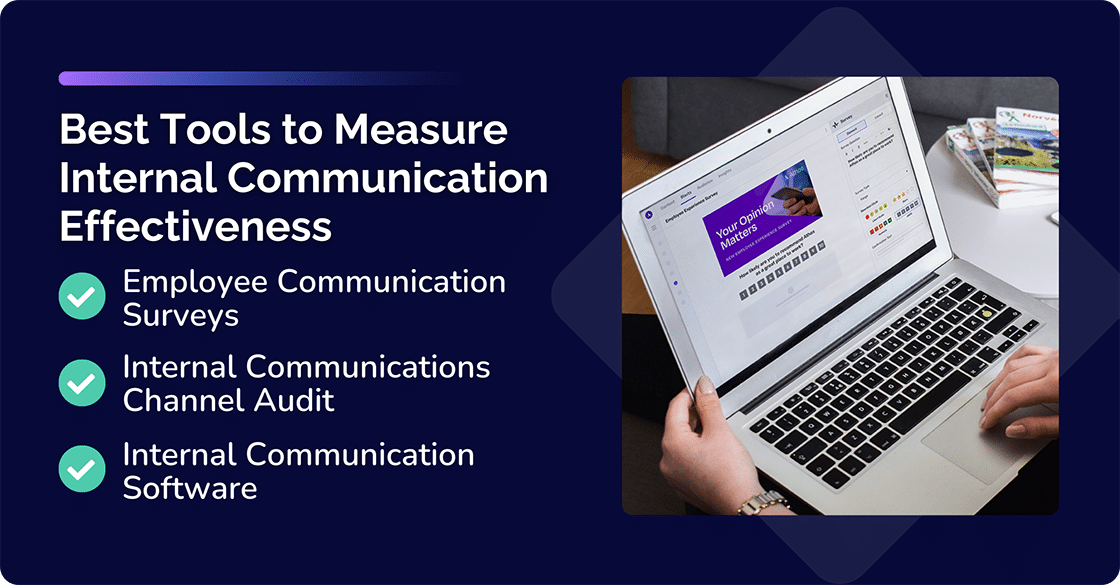
https://vimeo.com/729326023
If you want to improve your organization’s internal communications, a good place to start is with a ROI calculator. This will evaluate your existing channels to determine their effectiveness. Then we can get on with the job of helping you improve your internal communications plan.
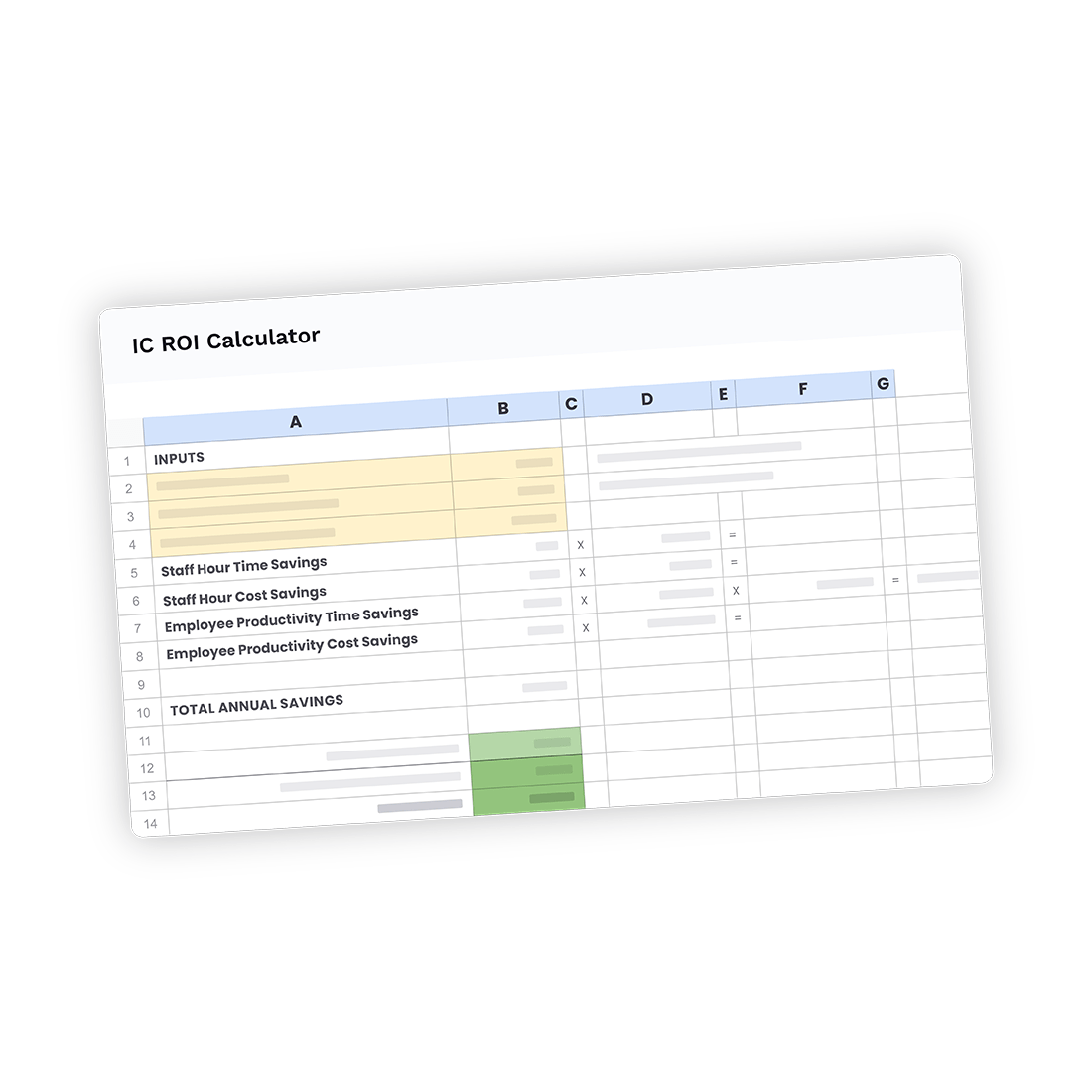
Quantify the financial benefits of your internal communications
What are KPIs for effective communication? Key performance indicators (KPIs) for effective communication include clear understanding, timely feedback, active engagement, and alignment with organizational goals.
What measures make communication effective? Effective communication is achieved through clarity in delivering messages, active listening, various feedback mechanisms, and being able to adapt to audience needs and preferences.
How do you assess effective communication skills? Assessment of effective communication skills involves evaluating clarity, active listening, nonverbal cues, empathy, and the ability to convey ideas so that they resonate with the intended audience.
What are the indicators of effective communication? Indicators of effective communication include mutual understanding, minimal misunderstandings, timely and constructive feedback, engagement, and the achievement of desired outcomes.

Quantify the financial benefits of your internal communications